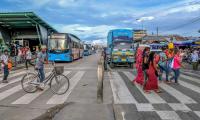How do we get mobility that creates more value than it destroys?
Mobility tends to be referred to as an almost unconditional good, which we as a society therefore put a lot of effort into providing and increasing. However, mobility is not free. Neither for the individual nor for society. And just as the value of mobility sometimes can be converted into money (e.g. time saved) and sometimes not (e.g. that the train runs regardless of whether you need it), and sometimes the costs can be priced (e.g. road maintenance) and sometimes not (e.g. loss of biodiversity).
Therefore, in the end, there is a need for a political balancing act on which societal capital (money, land, nature, …) is worth spending on creating mobility-related value, and for whom. For democratic reasons, however, such a balancing of dilemmas should be transparent and be made the subject of informed societal discussion, analysis, and planning.
When it comes to other societal matters (e.g. health), this typically takes place in the form of adopted strategies: What do we want to achieve, why and how. Having a national mobility strategy will also make it clearer, as described in CONCITO's analysis of infrastructure decisions, whether a given project proposal will be a step in the right direction.

CONCITO’s proposed strategy framework.
As a green think tank, our focus is the climate and environmental aspects. We are also aware of the other needs that a mobility strategy must address, but since deciding the overall balance is political, it is not up to CONCITO to come up with proposals for a fixed and finished mobility strategy. Yet we can see that the green considerations too often are lost or forgotten if the priorities are decoupled, therefore we find it important to get the necessary framework for this political balance. Both in order not to make the green transition more expensive than necessary and to ensure that the decisions made also make sense in a future where, for example, our climate goals are taken seriously.
In our new report 'National Mobility Strategy: Why, what and how' (in Danish), the above motivation is elaborated, and we make recommendations on how these new mindsets can be put into use. To kick-start the process, we also come up with a proposal for a concrete framework. The report's main recommendations are summarized below.
- 1. Make a paradigm shift in Danish transport policy
In a situation where the pressure on the climate, nature and physical resources is becoming increasingly problematic, there is a need to give up on the idea that more roads, railtracks and bridges and as a result more traffic is the default answer to all needs. The need for this change has been documented, and both industry players and politicians are requesting more strategic planning. The time is therefore ripe for the Minister of Transport to bring together a broad coalition of parties in an agreement to draw up a national mobility strategy.
In addition to agreeing on how this first strategy is drawn up and decided upon, the parties should also describe how the strategy can be updated, e.g. in the event of a change of government, without necessarily repeating the entire exercise.- 2. Set goals and manage according to them
Instead of the current approach of mainly projecting historical traffic patterns and investing on the basis of this (in professional terms called 'predict and provide'), there is a need to take stock of changed needs and limitations, whether local or planetary.
We therefore recommend a change of mindset to a more vision-based approach (in professional terms called 'vision and validate'), where a national mobility strategy sets out by defining which needs the transport sector must fulfil. These can be both quantitative, specific objectives or be more of a narrative-qualitative nature in the form of desired futures.
This is followed by a description of how the goals are to be achieved, both in terms of initiatives and management, taking the form of sub-strategies, plans, management principles etc.
- 3. Create commitment through a broad engagement of stakeholders
The transport sector’s purpose is to act as a lever for other sectors and goals in society, including climate, health, economy, labour market, business development, rural areas, trade, tourism, land use, nature, environment, etc. Therefore, a broad selection of stakeholders should be involved in uncovering needs and limitations. This should also include implementing organisations (such as municipalities and regions) and entities whose help the strategy depends on (e.g. the Ministry of Taxation).
The development of the strategi can take place under the auspices of a commission, in continuation of the work currently being done by the expert committee on public transport in rural areas. Inspiration is available in other cross-organizational public sector strategies, particularly in relation to involvement and anchoring.- 4. Revisit existing plans
When needs and limitations have been aligned and translated into visions, goals and management principles, existing plans should be revisited. Something may have to go out and something else come in. Something must be postponed while something else should be accelerated. And perhaps initiatives in completely new areas must be added (e.g. preparation of general road charging).
During the planning, the existing analysis tools (traffic models and socio-economic calculations) can be used to qualify the choice of different avenues to meet a given objective, in those situations where they are deemed be comprehensive and data-wise up to date.- 5. Follow up and revise
Both in Denmark and other countries, history has shown that it is necessary to follow up on the decided goals – are the planned activities leading to the goal quickly enough, and if not, is more to be done, or should the target be adjusted?
It makes best sense that the follow-up on any transport-related climate targets is included in the annual review cycle of the Danish Climate Act. In relation to other targets in the mobility strategy, we recommend the use of an independent panel of experts, that, for example, every two years (at least once per electoral term) compares the specified targets and goals with status and existing plans, and possibly on the basis of this, come up with a recommendation to change the strategy's management principles.
The panel should also be tasked with selecting infrastructure projects for review (or evaluation if completed), with a view to ensuring consistency between strategy and action.





